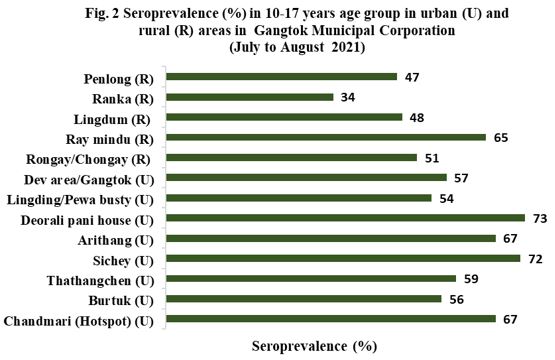Serosurveillance of COVID 19 among unvaccinated children aged 10-17 in Sikkim, North-Eastern India: A cross-sectional analysis
Abstract
Introduction: Serological studies offer valuable insights into the burden of diseases, especially among vulnerable populations. This preliminary serological survey for COVID19 was conducted among unvaccinated children aged 10-17 years in both urban and rural areas of East Sikkim, India, following the second wave of the pandemic. Conducting the study after the peak of transmission was deemed appropriate for a one-time cross-sectional investigation, to assess the prevalence of COVID19 in the region.
Methods: This cross-sectional study was conducted in 10 randomly selected urban areas and 9 rural areas within Gangtok Municipal Corporation. The survey team consisted of an accredited social health activist (ASHA), an anganwadi worker, and a laboratory technician. They conducted a household survey by randomly selecting households and obtaining informed consent from guardians. Demographic information was recorded, and blood samples were collected from participants. Antibody levels were estimated using the Cobas-e411 equipment and Roche’s Elecsys Anti-SARS-CoV-2 immunoassay reagent, which detects both IgM and IgG antibodies in human serum/plasma.
Results: A total of 1,104 participants were enrolled in the study. The overall seroprevalence rate was 58.24% (n=643), with urban areas contributing 39.24% (n=433) and rural areas contributing 19% (n=210). Seroprevalence did not significantly differ between genders, with 56.27% (n=269) of males and 59.74% (n=374) of females testing positive for SARS-CoV-2 antibodies. A significant difference was observed between symptomatic and asymptomatic participants, with seroprevalence rates of 71.25% and 57.22%, respectively, indicating higher antibody prevalence in symptomatic individuals. Among the seropositive participants, only 9% were symptomatic, while 91% were asymptomatic. The case-to-infection ratio (CIR) was 1:8, and the case fatality rate was zero for children aged 10-17 in this region.
Conclusions: Although seroprevalence has been increasing nationally, a portion of the population remains seronegative. The case-to-infection ratio suggests that many infections go undetected or unreported. This data highlights that the actual number of COVID19 infections was significantly higher than the number of confirmed cases reported by testing. Continued monitoring and targeted public health measures are essential to address the COVID19.
Downloads
References
2. Mangla S, Zohra Makkia FT, Pathak AK, et al.: COVID-19 Vaccine Hesitancy and Emerging Variants: Evidence from Six Countries. Behav Sci (Basel). https://covid19.who.int/, 10.3390/bs11110148
3. Coronavirus Updates: Sikkim reports its first COVID-19 case. (2020). Accessed: 10 oct 2022: https://www.thehindu.com/news/national/other-states/coronavirus-sikkim-reports-first-covid-19-case/article31659737.ece.
4. Andrews MA, Areekal B, Rajesh KR, et al.: First confirmed case of COVID-19 infection in India: A case report. Indian journal of medical research. 10.4103/ijmr.IJMR_2131_20
5. 155% New Covid Cases in Sikkim During 2nd Wave, 49% Deaths Due To Covid. (2021). Accessed: 12 oct 2022: https://www.ndtv.com/india-news/sikkim-coronavirus-155-new-covid-cases-in-sikkim-during-2nd-wave-49-deaths-due-to-cov....
6. World Health Organization. (2020). Population-based age-stratified seroepidemiological investigation protocol for COVID-19 virus infection. (2020). Accessed: 12 oct 2022: https://iris.who.int/handle/10665/331656.
7. Sikkim Population. (2020). Accessed: 12 oct 2022: https://www.indiacensus.net/states/sikkim.
8. Gangtok Town Population Census 2011 - 2024. Accessed: 12 oct 2022: https://www.census2011.co.in/data/town/801421-gangtok-sikkim.html.
9. Elecsys® Anti-SARS-CoV-2. Accessed: 12 oct 2022: https://diagnostics.roche.com/global/en/products/params/elecsys-anti-sars-cov-2.html.
10. Murhekar MV, Bhatnagar T, Thangaraj JWV: Seroprevalence of IgG antibodies against SARS-CoV-2 among the general population and healthcare workers in India, June-July 2021: A population-based cross-sectional study. PLoS Med. 10.1371/journal.pmed.1003877
11. Murhekar MV, Bhatnagar T, Selvaraju S: SARS-CoV-2 antibody seroprevalence in India, August-September, 2020: findings from the second nationwide household serosurvey. Lancet Glob Health. 2021, 10.1016/S2214-109X (20)30544-1
12. Murhekar MV, Bhatnagar T, Thangaraj JWV, et al.: SARS-CoV-2 seroprevalence among the general population and healthcare workers in India, December 2020-January 2021. Int J Infect Dis. 2021, 10.1016/j.ijid.2021.05.040
13. Sikkim Concerned After Delta Variant Found In 97 Of 98 Samples Studied. (July 20, 2021). Accessed: 11 oct 2022: https://www.ndtv.com/india-news/sikkim-concerned-after-delta-variant-found-in-97-of-98-samples-studied-2491015.
14. Zimmermann P, Curtis N: Why is COVID-19 less severe in children? A review of the proposed mechanisms underlying the age-related difference in severity of SARS-CoV-2 infections. Arch Dis Child. 2020, 10.1136/archdischild-2020-320338
15. Tony Kirby: Evidence mounts on the disproportionate effect of COVID-19 on ethnic minorities. Lancet Respir Med. 2020, 10.1016/S2213-2600(20)30228-9
16. Lopez-Pena P, Austin Davis C, Mushfiq Mobarak A & Raihan S: Prevalence of COVID-19 symptoms, risk factors, and health behaviors in host and refugee communities in Cox’s Bazar: a representative panel study. Preprint]. Bulletin World Health Organization. 2020, 10.1016/S2214-109X (20)30282-5
17. Yang HS, Costa V, Racine-Brzostek SE: Association of Age With SARS-CoV-2 Antibody Response. JAMA New Open. 2021, 10.1001/jamanetworkopen.2021.4302.
18. Ibarrondo FJ, Fulcher JA, Goodman-Meza D, et al.: Rapid Decay of Anti-SARS-CoV-2 Antibodies in Persons with Mild Covid-19. N Engl J Med. 2020, 10.1056

Copyright (c) 2024 Author (s). Published by Siddharth Health Research and Social Welfare Society

This work is licensed under a Creative Commons Attribution 4.0 International License.


 OAI - Open Archives Initiative
OAI - Open Archives Initiative


